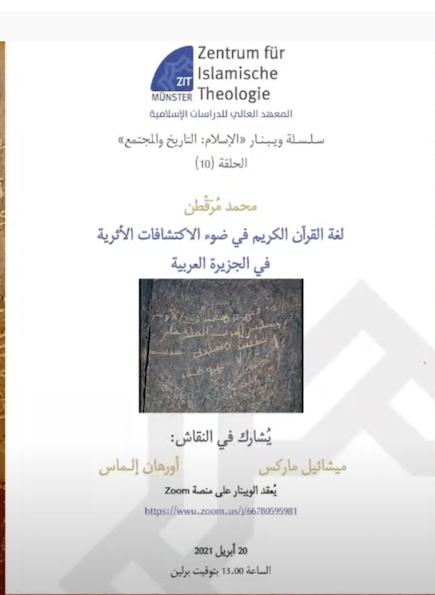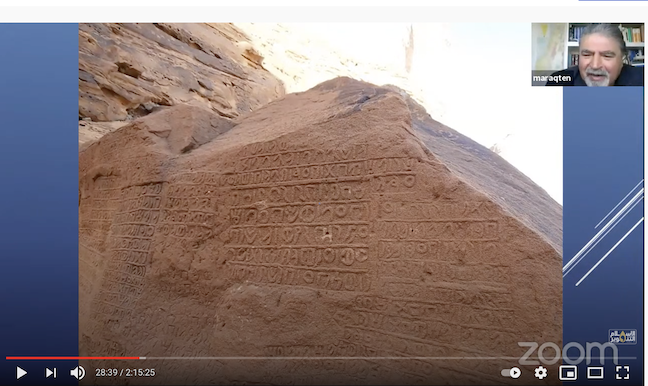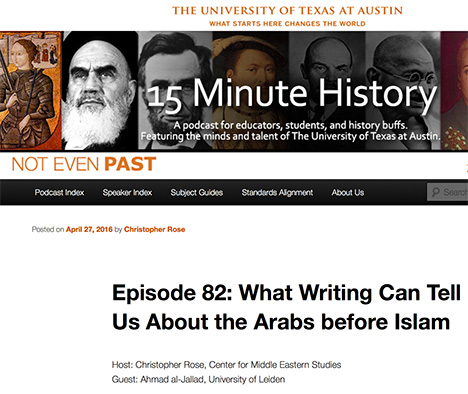Dr. Muhammad Maraqten, the distinguished archaeologist and specialist on ancient pre-Islamic languages of the Arabian Peninsula, delivered a lecture almost a year ago on our knowledge of the language of the Qu’ran based on the findings of surviving inscriptions in earlier languages. His talk is in Arabic and it is well illustrated.
Category Archives: Archaeology and Antiquities
Parading with the Pharaohs
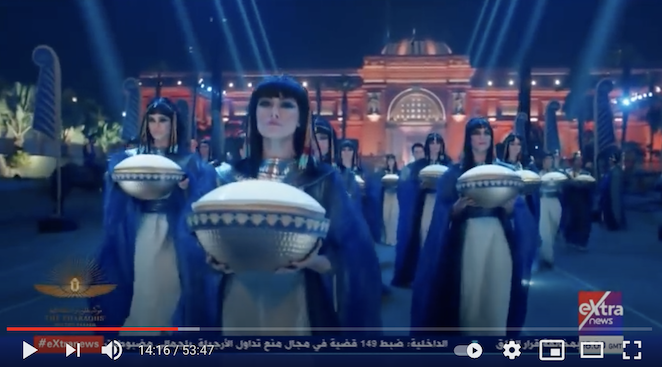
Yesterday there was an extravaganza parade in Cairo parading the embalmed remains of 22 ancient Egyptian pharaohs to their new “eternal” resting place in the National Museum of Egyptian Civilization. You can and should watch the entire show, which you can do here. It featured a major musical composition of Mahleresque length, at times rivaling the soundtrack of Star Wars, but with a lot of drumming to match the pace of the parade. The parade included Egyptian women, shown above, and men dressed in “pharaonic” costume (with a Hollywoodish make-over), men in chariots and coffinesque vehicles carrying the pharaohs and their consorts. On the screen in the auditorium for the elite guests of President el-Sisi, there were scenes of several monuments and dance routines that might best be called an Orient Side Story. You can read all about it here.
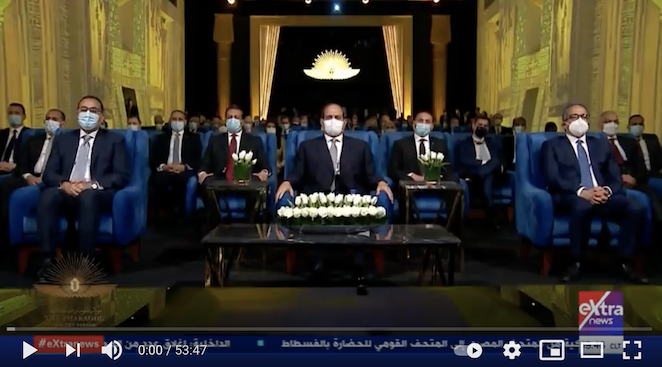
The star of the show was the modern day would-be Ramses, President Abdel Fattah el-Sisi, who was front and center before the staged event. He sat like a stoic behind a Covid mask for well over an hour; then as the caravan of his ancestral rulers neared the new museum, there is a scene of several minutes as he walks through the corridors, a smile on his face, to greet the mummies. The reason for spending a large amount of government funds on such a show is obvious: Egypt is desperate to revive the tourism industry. The choreographed show happened at night, with what appear to be few spectators, but the real audience was for those abroad. As one of the speakers said, the heritage of Egypt is the heritage of the entire world.
Presenting Egypt to the world of potential tourists is at the same time sending a message that Egypt is not a dangerous Islamic haven for terrorists, certainly not for the Muslim Brothers after el-Sisi took power. The heritage celebrated in the show was not Islamic, although the theme of ancient Egyptian faith and justice harmonizes with the positive view of Islam the tourism industry must push. The orchestra looked like any classical music orchestra in the world. The close-ups of the players showed most women performers without hijab, as was also the case for the main singers on stage. The only dress visible in the show was what would be seen as modern Western attire, elaborate stage dresses for the singers and supposedly ancient Egyptian costume.
I enjoyed the pomp and pop-cultured kitsch, and the music was enthusiastic in the best way. It was indeed a celebration of Egypt, with an echo of the extravaganza of 1912, when the opera Aida was performed at the foot of the Pyramid of Cheops. I do not know of a recording from that performance, but here is Caruso’s rendition of “Celeste Aida” from 1908. I have no idea how many people watched that performance, but I suspect it was the better-off beys and not the peasant farmers. By the way, Verdi’s Aida was was commissioned by the Khedivial Opera House in Cairo and had its premiere on 24 December 1871.
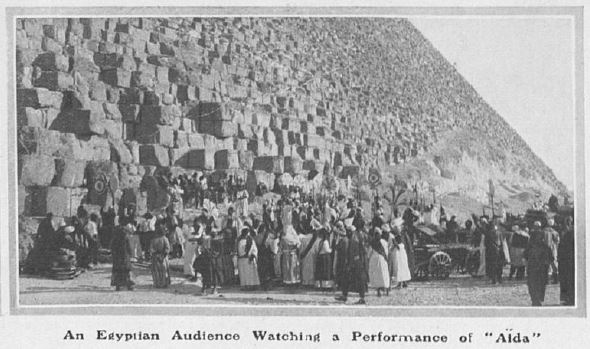
The idea of the ruler overseeing a parade is a remake of ancient Egyptian rituals, where it was important to renew the divinity of the ruler, a historic note that perhaps made el-Sisi smile in the corridor. After all, wouldn’t all Egyptian peasants have adored their pharaoh, so happy to spend years lugging stone after stone to erect a monstrous resting place for their master? It’s a wonder why the Hebrews didn’t stay and keep making mudbricks instead of almost drowning in the Red Sea and ending up in the desert for 40 years…

Autocrats, no matter whether they are benevolent or not, love nationalistic parades. In 1971 the Shah of Iran celebrated the founding of the Achaemened by Cyrus the Great 2,500 years earlier. The Soviet Union and China love their military parades and Donald Trump tried to pull one off for Washington DC off when he was in power.
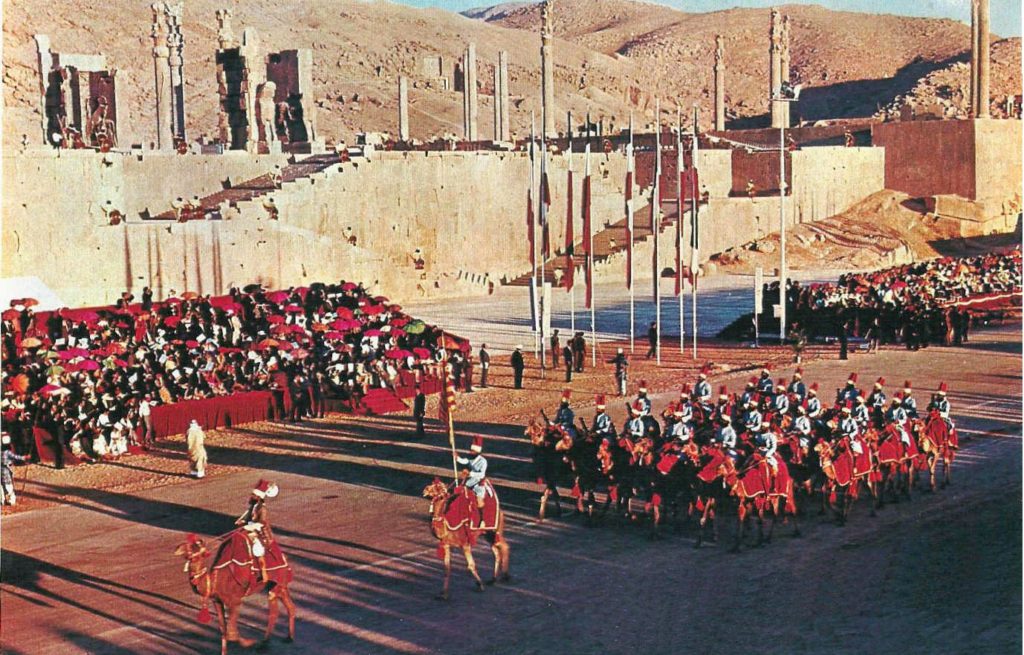
As someone who grew up wanting to be a Biblical Archaeologist and who started a graduate career planning to be a Near Eastern archaeologist, I have long been under the spell of the ancient Egyptians. My visit to the Cheops Pyramid when it was still possible to shimmy up the narrow passage to an empty tomb room and my walk around the ruins of Luxor left memories that continue to this day. If you have not seen these wonders, you should plan to visit Egypt at some point. But Egypt also hosts incredible monuments and historical objects from the Islamic era, especially the early Mamluk period. The entire history of Egypt is worthy of a parade, but only as long as we remember that poverty is still endemic in the country, the ills that led to the Arab Spring have not disappeared, and democracy has taken a back seat.
Oldest Beer Site
Check out this report in The Guardian on what may be the oldest site for producing beer in the world. Of course it was discovered by archaeologists…
Geocolonialism and the War in Yemen

In April Secretary-General Antonio Guterres called the situation in Yemen the world’s worst humanitarian crisis. After more than three years of a lopsided war between a Western-supported Saudi/Emirati coalition and a rebel group in control of the capital Sanaa and most of the estimated 28 million Yemenis, the crisis is only getting worse.
Now coalition forces are attempting to wrest control of the vital port of Hodeidah from the Huthi forces, thinking that such a loss would force the Huthis to accept their terms for a total submission. Since this port supplies most of the food and aid entering Yemen, loss of the port would likely trigger a siege to literally starve the Huthi areas into submission. The Huthis know this and are not likely to give up the port without a bloodbath. Meanwhile several hundred thousand residents fear for their lives and many have already fled to areas with no resources whatsoever. The UN fears a renewed outbreak of cholera, which has already affected more than one million Yemenis. Negotiations continue by the UN Special Envoy Martin Griffiths to stop the impending violence.
But in the midst of all this turmoil, one recent pundit argues that the eastern province of Marib, firmly in control of the Saudi/Emirati alliance, shows how one province succeeds in the midst of Yemen’s war. Not only is this sparsely populated and oil-rich area considered a success, it is said to be “thriving.” A football stadium with German turf and according to FIFA standards is being constructed and there is a new university for 5,000 students. The biblical land of the Queen of Sheba and famous Marib dam mentioned in the Quran (which was bombed at one point by the Saudis) is said to be “regaining a slice of its historical importance.”
So what is the lesson for Yemen’s future from this miracle in the desert? For journalist Adam Baron “Marib’s experience holds wider lessons for Yemen’s future: embracing decentralisation, empowering local actors, and focusing on ground-up stabilisation are all strands of the story that international and local players interested in bringing peace and stability to Yemen should note.” The main local actor here is a tribal sheikh named Sultan Arada, drawing on support of the conservative Islah movement. With outside money pouring in, he has morphed into the sultan of a fiefdom. The current “stability” is grounded not on local concerns but from the top-down flow of money from the neighboring international players, Saudis and Emiratis.
Yemen’s future is not in Marib, nor in building state-of-the-art FIFA stadiums in a country with a ravaged infrastructure, ongoing water crisis and sectarian violence fueled by the grueling three years of war. Marib is currently a colony of the Saudis, just as the Emiratis would like to take control of the island of Socotra and the port of Aden. The two wealthiest states of the now moribund GCC are carving out their zones of influence on the backs of people in the poorest country in the Arabian Peninsula. Without the billions of dollars worth of weapons and strategic intelligence from the West, this war dividend could never have been realized.
Welcome to the latest, post-Cold War twist in the land once thought to be Holy. It is no longer direct Western intervention but a shared geocolonialism, in which the proxy war between Saudi Arabia and Iran is applauded and abetted by Western leaders. Muhammad bin Salman’s recent trip to the U.S. sold his snake-oil reform in exchange for buying more weapons and all that he assumes oil-drenched money can buy. Meanwhile the Saudi abysmal track record on human rights and the war crimes of the Saudi-led coalition in Yemen are ignored. If Marib is the model for Yemen’s future, then the only democracy, for its flaws, in the Arabian Peninsula will be geocolonized into yet another make-believe kingdom or emirate.
Arabic Writing before Islam
In most world history survey courses, Arabia is introduced for the first time only as backstory to the rise of Islam. We’re told that there was a tradition of oral poetry in Arabic, a language native to central Arabia, and that the Qur’an was the zenith of this oral tradition. New evidence, however, suggests that Arabia was linguistically diverse, that the language we’ve come to know as Arabic originated in modern day Jordan, and that the looping cursive writing system that’s become the language’s hallmark wasn’t the original system used to write it. What to make of all this?
Guest Ahmad al-Jallad co-directs archaeological/epigraphic projects in Jordan and Saudi Arabia, uncovering new inscriptions thousands of years old, and shares his research that’s shedding new light on the writings of a complex civilization that lived in the Arabian peninsula for centuries before Islam arose.
Click here to hear the broadcast.
Metropolitan Museum of Art Books
You can download fifty years of publications by the Metropolitan Museum of Art for free. Yes, for free. There are books on the art of Islamic Spain, Egypt, the Near East, etc. Check it out here.
Muslims in Medieval France

Early Medieval Muslim Graves in France: First Archaeological, Anthropological and Palaeogenomic Evidence
Yves Gleize ,
Fanny Mendisco ,
Marie-Hélène Pemonge,
Christophe Hubert,
Alexis Groppi,
Bertrand Houix,
Marie-France Deguilloux,
Jean-Yves Breuil
Published in PLOS/ONE, February 24, 2016
Abstract
The rapid Arab-Islamic conquest during the early Middle Ages led to major political and cultural changes in the Mediterranean world. Although the early medieval Muslim presence in the Iberian Peninsula is now well documented, based in the evaluation of archeological and historical sources, the Muslim expansion in the area north of the Pyrenees has only been documented so far through textual sources or rare archaeological data. Our study provides the first archaeo-anthropological testimony of the Muslim establishment in South of France through the multidisciplinary analysis of three graves excavated at Nimes. First, we argue in favor of burials that followed Islamic rites and then note the presence of a community practicing Muslim traditions in Nimes. Second, the radiometric dates obtained from all three human skeletons (between the 7th and the 9th centuries AD) echo historical sources documenting an early Muslim presence in southern Gaul (i.e., the first half of 8th century AD). Finally, palaeogenomic analyses conducted on the human remains provide arguments in favor of a North African ancestry of the three individuals, at least considering the paternal lineages. Given all of these data, we propose that the skeletons from the Nimes burials belonged to Berbers integrated into the Umayyad army during the Arab expansion in North Africa. Our discovery not only discusses the first anthropological and genetic data concerning the Muslim occupation of the Visigothic territory of Septimania but also highlights the complexity of the relationship between the two communities during this period.
For the complete article, click here.
As Sanaa Becomes Aleppo
With reports of Saudi coalition troops massing on the border to invade Yemen, the situation in Yemen gets even more dangerous. Will the beautiful Old City of Sanaa become the next Aleppo?
